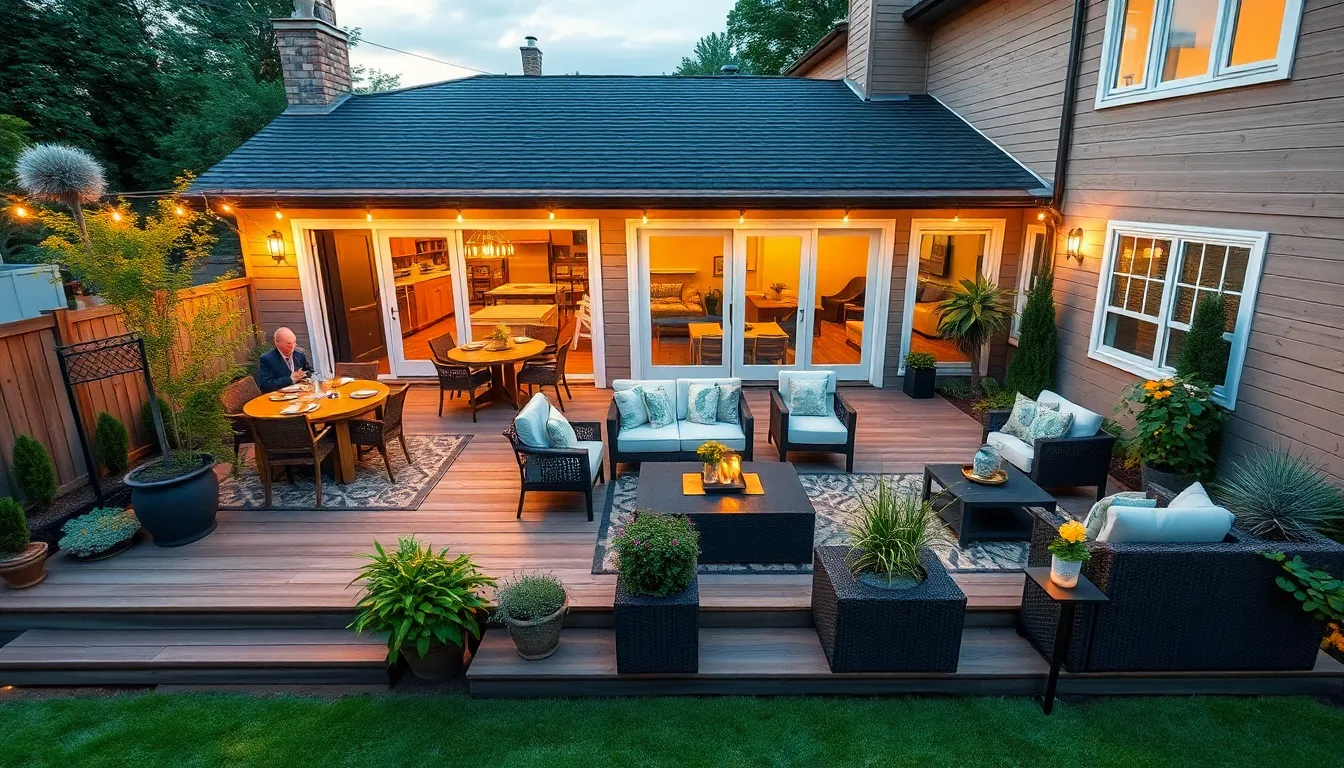A well-planned deck layout can transform any outdoor space into a functional and inviting area. Whether it’s for entertaining guests or enjoying quiet evenings under the stars, the right design makes all the difference. Understanding the essential elements of deck layout helps homeowners maximize their space and create a seamless flow between indoor and outdoor living.
From choosing the ideal materials to considering furniture placement, every detail matters. Thoughtful deck layouts not only enhance aesthetics but also improve usability and comfort. With the right guidance, anyone can design a deck that reflects their personal style while meeting their practical needs. Dive into the key aspects of deck layout and discover how to create the perfect outdoor oasis.
Table of Contents
ToggleOverview of Deck Layout
A well-thought-out deck layout significantly influences outdoor space functionality and appeal. The design process involves several critical elements that can enhance both performance and aesthetic qualities.
Essential Elements of Deck Layout
- Zoning: Creating distinct areas for different activities—such as dining, lounging, or cooking—helps maximize utility.
- Flow: Ensuring a natural flow between indoor and outdoor areas promotes accessibility and movement. Consider pathways and transitions that connect the deck to the house.
- Furniture Placement: Selecting furniture that aligns with intended activities can optimize space usage and comfort. Arrange seating to facilitate conversation and interaction.
- Material Selection: Choosing durable materials contributes to long-term aesthetics and usability. Options like composite decking or natural wood can enhance visual appeal.
- Environmental Considerations: Assessing sunlight, shade, and prevailing winds influences layout decisions. Incorporate features such as awnings or planters for climate adaptation.
- Safety Features: Implementing railings, non-slip surfaces, and adequate lighting ensures a safe environment for everyone using the deck.
By prioritizing these elements, homeowners can create a deck layout that not only enhances outdoor experiences but also reflects individual style and preferences.
Importance of Deck Layout in Design

A well-organized deck layout enhances both the functionality and aesthetics of outdoor spaces. Understanding how layout affects a deck’s usability and visual appeal is critical for achieving the desired atmosphere.
Functionality and Aesthetics
Functionality is paramount in deck design. Designing distinct zones for dining, lounging, and cooking allows homeowners to maximize the utility of their spaces. Placing furniture thoughtfully increases interaction and comfort, encouraging social activities. Selecting suitable materials, such as weather-resistant composites or natural woods, elevates both the appearance and longevity of the deck. Incorporating plants and décor can further enhance aesthetics, creating an inviting environment.
Impact on Spatial Organization
Spatial organization influences how individuals navigate and enjoy the deck. Utilizing the available square footage wisely prevents overcrowding and promotes a natural flow between areas. Aligning furniture along pathways ensures easy movement between indoor and outdoor spaces. Zoning helps delineate activities such as grilling or relaxing, which enhances the overall experience. Keeping safety features in mind, like properly positioned railings and lighting, also contributes to effective spatial organization.
Key Elements of Effective Deck Layout
Effective deck layout depends on several critical elements that enhance usability and aesthetics. Key factors include size and shape considerations, as well as furniture and layout configuration.
Size and Shape Considerations
Determining the deck’s size and shape establishes the foundation for effective design. He or she should assess available space to identify suitable dimensions that accommodate desired activities. Standard deck sizes often range from 10×10 feet for small spaces to larger configurations exceeding 20×30 feet for expansive areas.
The shape of the deck significantly influences functionality. Rectangular decks suit straightforward layouts for dining and lounging, while irregular shapes can create cozy nooks and distinct zones. Homeowners may consider proximity to entry points and views, ensuring that the design maximizes accessibility and aesthetics.
Furniture and Layout Configuration
Furniture selection and arrangement play a vital role in deck functionality and comfort. Homeowners should choose weather-resistant materials, such as aluminum, teak, or synthetic wicker, to ensure durability.
He or she should prioritize seating arrangements that facilitate conversation and interaction. For instance, placing sofas or chairs in circular patterns encourages engagement, while adding tables within arm’s reach enhances convenience.
Navigating space is crucial; leaving at least 2-3 feet between furniture pieces allows for easy movement and accessibility. Additionally, incorporating multi-functional furniture, such as storage benches or foldable tables, optimizes space and versatility. By carefully considering furniture types and layout, homeowners create inviting outdoor environments that cater to both relaxation and entertainment.
Common Deck Layout Styles
Deck layouts come in various styles, each offering unique benefits and aesthetics. Understanding these common styles aids in selecting the ideal design for outdoor spaces.
Open Concept Layout
Open concept layouts emphasize spaciousness and fluidity. They combine multiple functional areas within a single layout to foster connectivity. Homeowners often incorporate seating arrangements that invite conversation and relaxation. Dining areas typically adjoin lounge spaces to create an inviting atmosphere. Open designs enhance movement, making it easier for guests to transition between activities. Natural materials like wood or composite decking promote a cohesive look.
Multi-Level Decks
Multi-level decks add visual interest and appeal to outdoor spaces. These layouts leverage elevation changes to create distinct zones, ideal for various activities. Homeowners can designate separate levels for dining, lounging, or cooking, optimizing space usage. Stairs or transitions between levels often enhance accessibility and flow. Multi-level configurations also accommodate diverse landscape features, such as slopes or gardens. Using railing and lighting differentiates areas while enhancing safety and ambiance.
Tips for Planning Your Deck Layout
Planning a deck layout involves careful consideration of various factors that impact usability and aesthetics. Following these tips will help achieve a functional and visually appealing outdoor space.
Assessing Space and Landscape
Assess available space by measuring the deck area before making any design decisions. Consider the dimensions of the yard and any existing features such as trees, slopes, or pathways. Analyze the purpose of the deck to determine appropriate sizes for different zones, like dining and lounging areas. Prioritize flow by ensuring ample pathways between zones, reducing congestion. Evaluate the surrounding landscape to enhance the deck’s integration with the environment, utilizing natural elements to create a cohesive look.
Choosing the Right Materials
Choose materials based on durability, maintenance, and style. Opt for weather-resistant options such as composite decking or treated wood that withstand harsh conditions. Select materials that complement the home’s architecture and landscape while also considering color and texture. Implementing non-slip surfaces on walking areas boosts safety, especially in wet conditions. Incorporate eco-friendly options where possible to promote sustainability and long-term use. Analyze maintenance requirements to ensure materials align with the desired upkeep level.
A thoughtfully designed deck layout can significantly enhance outdoor living experiences. By prioritizing functionality and aesthetics homeowners can create inviting spaces that cater to both relaxation and social interaction.
Focusing on distinct zones ensures that each area serves its purpose effectively while promoting a natural flow between indoor and outdoor environments. Selecting durable materials not only boosts the deck’s longevity but also adds to its visual appeal.
Ultimately a well-planned deck layout transforms an ordinary outdoor space into a personal oasis where memories are made and cherished.


